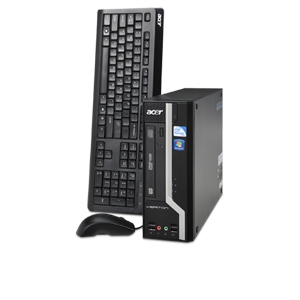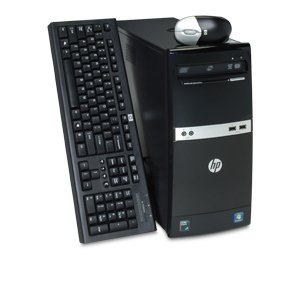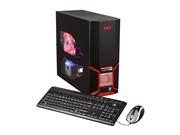Back To School Technology Buyer's Guide
by Zach Throckmorton on August 4, 2011 8:55 PM ESTRetail desktops
Component for component, retail desktops rarely offer as much value or flexibility as a comparable DIY desktop, especially if as a student you have access to heavily discounted OS licenses. However, retail desktops are often a good choice if the primary user is not especially tech-savvy. Retail desktops come with technical support and straightforward warranties. That is, they're potentially less of a headache in case something goes awry. When shopping for retail desktops, it is very important to shop around for remarkable sales. That said, we outline below what you can typically expect at four different price points.
Less than $300

At $300, retail desktops typically feature previous-generation CPUs, less than 4GB of memory, smaller hard drives, and integrated (i.e. non-gaming) graphics. That said, these very inexpensive PCs are still up to basic productivity tasks like web browsing and document creation, as well as sound and video playback. The Acer Veriton VX275-UD5800W is an example of such a computer. Its dual-core Intel Pentium E5800 processor is based on a CPU architecture that is now two generations old, it has 2GB of RAM, and a 320GB hard drive. It's an attractive choice for college students because it's tiny—16" deep by 4" wide by 11" tall. Its 4" width is a small desk footprint; it could easily be placed on a typical dorm room desk while leaving plenty of room for other items. Considering the very low cost of RAM, upgrading it to a more comfortable 4GB would cost less than $15.
Around $400

At $400, give or take, retail desktops start having good enough hardware that you can get four years of basic usage from them. Budget current-generation processors, 4GB RAM, smaller hard drives, and integrated graphics are typical in this price range. HP's 505B has specifications similar to the AMD micro-ATX system outlined on the previous page. The most important difference is the HP's PSU is 300W, and like most retail computer PSUs, it's likely not even capable of supplying that much electricity. The weak PSU severely limits this system's expandability in terms of adding more hard drives or a GPU. Also, the HP case is not nearly as attractive as the Fractal Core 1000! That said, it's a solid value at just over $400.
Around $500

As a long-time computer enthusiast, it truly amazes me how much power can be purchased for $500 today. At $500, lower mid-range CPUs, more than adequate 6GB or 8GB of memory, and large hard drives abound, though these systems usually lack discrete GPUs (if you're not gaming, this does not matter). The Gateway DX4850-45u is exactly $500, has a quad core Intel Core i5 CPU, 6GB DDR3, and a 1TB hard drive. This system is respectably powerful today, and it will be very serviceable in four years. Its chassis also includes a few niceties like easily-accessible media card readers and more than typical USB ports. Its optical drive not only reads and writes CDs and DVDs, it can also read Blu-ray discs. WiFi is integrated. Unfortunately it also includes an anemic 300W PSU, so upgrading it with anything more powerful than a low-end gaming GPU will require upgrading the power supply as well.
Around $700

At $700, retail PCs typically contain higher mid-range processors, 8GB RAM, large hard drives, and begin to include decent gaming GPUs. You usually get better bang for the buck at this point if you get away from the Dell and HP systems, where there's a major premium for decent graphics cards, and that's what we've selected here. CyberpowerPC's Gamer Xtreme 1314 houses the very capable Intel Core i5-2500K CPU, 8GB memory, a 1TB hard drive, and an AMD Radeon HD 6670 GPU. AnandTech reviewed the 6670 a few months ago and found it to be capable of producing acceptable frame rates (i.e. 30FPS or higher) in most games at resolutions less than 1080p and medium settings. The 6670 is not an enthusiast gamer's card, but it's okay for casual gamers, or hardcore gamers who like older titles (think World of Warcraft). Unfortunately, its motherboard will not facilitate overclocking the Core i5-2500K. Note that as the cost of the retail PC has risen on this page, so has its performance discrepency with the comparable DIY system. The Intel Core i5-2500K-based PC on the previous page has an enthusiast gamer-grade GPU, an SSD, a more feature-rich and overclockable motherboard, an aftermarket CPU heatsink for better overclocking results, and a much higher quality power supply for less than $100 more than this retail PC.
Now that we've covered both build your own and pre-built systems, the next page looks at what you'll actually be looking at: monitors.










94 Comments
View All Comments
rageguy34 - Thursday, August 4, 2011 - link
I'm surprised that you would even mention USB keys given how easy they are to lose or an external hard drive seeing as how they can also get lost or have a mechanical failure. Every student should use dropbox or another alternative if not only for cloud storage but for the version history on document saves as wellbrshoemak - Thursday, August 4, 2011 - link
Losing a USB key is not the fault of the hardware. External drives, like anything else can fail. I agree that Dropbox (or like services) should be a part of a student storage plan but other methods of data redundancy are fine. Keep in mind there are times where you need to go to campus computer labs to print certain specialized documents or need color laser prints, most students aren't rocking color lasers in their dorm rooms. Those lab PC's are locked down so you have no way to install Dropbox to get your files - a flash drive is required in those instances, so they can't be totally discounted.zshift - Friday, August 5, 2011 - link
Dropbox has a web interface. I haven't used a flash drive since I created my Dropbox account, and it provides multiple points of backup if you use it on multiple computers. For a student, the spacing limitations shouldn't be too much trouble, especially since referrals net the user extra space. Last I checked, docs, presentations, spreadsheets, and even a few songs or pics here and there don't fill up my Dropbox. I have 2 years worth of material on there, accessible from anywhere I can get an internet connection. Plus, I've lost every flash drive I've ever owned.Zoomer - Friday, August 5, 2011 - link
A flash drive is so much faster than mucking around with some web interface, particularly when the paper is due in -10 minutes.nickb64 - Friday, August 5, 2011 - link
I bought a 16GB USB Key last year because my school blocked the dropbox domain, and I got it on sale on Amazon for $20, which I felt was a pretty good deal, since it was only a dollar more than the 8GB model by the same company.I can access Amazon Cloud Storage from school, but it's a pain in the ass to keep it and Dropbox with the same files in case I need them. Having something in Dropbox is useless if I have to use it in a lab where I don't have access to the Dropbox site.
I just bought a 4-pack of 4GB USB keys because my old 2GB one was too small for my sister's needs, and I can keep various utilities on another in case I need to use them to help someone I know with a computer issue. Also, they were really cheap.
nafhan - Friday, August 5, 2011 - link
Different students are going to have different storage needs. Dropbox will be fine for Word Docs (and has other advantages, as you mentioned), but someone working with large media files will need at least a thumb drive or a mechanical hard drive to get enough space.Procurion - Monday, August 8, 2011 - link
Cloud....meh....I call it pie-in-the-sky. I choose to remain in control of my programs and my privacy, not relenquish it to an unknown group of for profit individuals. Anyone remember Wikileaks???? Nothing on the intenet is "safe".Nataku - Friday, August 5, 2011 - link
no offense, but cloud storage just isn't be all end all solutionthere are plenty of reasons, but to name just a few
- >1GB file download or USB transfer? USB is a hell a lot more faster
- firewall blockage + paranoid IT security will own you when u thought u could download ur powerpoint for the presentation happening in 5 min
- no internet connection --> hey my school kept printing stations off the net so u have to use USB drives
- entering ur username/password on a pub PC that may have keylogger and ur dropbox account having personal stuff, (self video of triple x stuff.. j/k lol)
StormyParis - Thursday, August 4, 2011 - link
As a student, I worked at the Computer Lab. That was back in 5"1/4 floppies day, but the broad 50% of people coming in about lost/corrupted/destroyed data or equipment has stayed about the same.So please kids, do backups. And remember, backups are
- offline, so a virus (or a pissed ex) that wipes your stuff can't get to your backups.
- offsite, so the thief that empties your dorm room nor the idiot that drowns it can get to it
- several, because of murphy's law: your backup will go bad the day your laptop gets stolen.
- tested, because quite often you think you're backuping stuff only to realize that your app does not pout its docs in the user directory.
Also, buy cheap stuff. I know youngsters always need ego-boosters, and branded overskill tech stuff is a nice personnality crutch. Keep in ming though, that it's a waste of money, it's likelier to get stolen, it makes it worse when it's stolen / damaged... and, really, you should try being what you do, not what you own.
techhhhhhy - Thursday, August 4, 2011 - link
I'm sorry, but this was clearly written by someone who doesn't go to college and doesn't know what's right for a campus.There is no way, 0 chance that you can use a desktop on a college campus / dorm. Does it work? Yes but it is absolutely retarded idea.
I could have made this article in 1 page. Get a 15" or less laptop, 13" is ideal. Portability is key in college. If you can afford it get a Macbook because this is what 75% of your classmates will have.